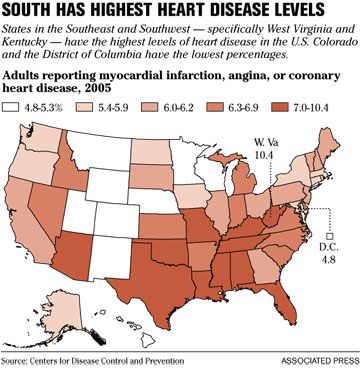Hawaii among 9 with low rate of cardiac disease
Prevalence varies with ethnicity and is high in some groups
Hawaii is one of nine "white states" with lowest levels of coronary heart disease, the Centers for Disease Control and Prevention has reported. Other areas with low incidence of heart disease were Nebraska, Wisconsin, Wyoming, New Mexico, Montana, Minnesota, Utah, Colorado, the District of Columbia and the Virgin Islands.
The report lists the percentage of people living with heart disease in all the states and U.S. territories based on a random phone survey with adults 18 and older conducted by state and territorial health departments.
Rates for heart attacks ranged from 2.1 percent in the Virgin Islands to 6.1 percent in West Virginia. Hawaii's rate was 3.4 percent.

HEALTHIEST HEARTS
The Centers for Disease Control and Prevention has reported:
» Areas with low incidence of heart disease were Hawaii, Nebraska, Wisconsin, Wyoming, New Mexico, Montana, Minnesota, Utah, Colorado, the District of Columbia and the Virgin Islands.
» Rates for heart attack ranged from 2.1 percent in the Virgin Islands to 6.1 percent in West Virginia. Hawaii's rate was 3.4 percent.
» The prevalence of heart attack, angina or coronary heart disease ranged from 3.5 percent in the Virgin Islands to 10.4 percent in West Virginia. Hawaii's rate was 4.9 percent.
|
|
The prevalence of heart attack, angina or coronary heart disease ranged from 3.5 percent in the Virgin Islands to 10.4 percent in West Virginia. Hawaii's rate was 4.9 percent.
Don Weisman, American Heart Association communications, marketing and government affairs director, said it is not surprising that isle incidence rates are low, because Hawaii's coronary heart disease death rate is the lowest in the country.
Hawaii is second lowest in cardiovascular death rates overall, although stroke deaths are higher, ranking 19th among the 50 states, the District of Columbia and Puerto Rico, he said.
Even though Hawaii has low heart disease prevalence and death rates, certain ethnic groups have among the highest rates in the country, Weisman said.
Native Hawaiians have a high death rate from heart disease, and stroke death rates are high among Filipinos, he said.
Certain pockets of the state, such as Kona on the Big Island, also have high death rates from stroke, he said.
The CDC report "Prevalence of Heart Disease -- United States, 2005" was published in a Morbidity and Mortality Weekly Report.
Men had a higher rate of coronary heart disease, nonfatal heart attack and angina than women -- 8.2 percent versus 5 percent.
American Indians and Alaska natives had the highest rate of heart disease, 11.2 percent, and Asians had the lowest, 4.7 percent.
People with less than 12 years of education had a heart disease rate nearly twice as high as college graduates -- 9.8 percent compared with 5 percent.
"These findings show the importance of preventing and controlling known risk factors for heart disease, such as high blood cholesterol, tobacco use, physical inactivity, high blood pressure, Type 2 diabetes and obesity," said Jonathan Neyer, CDC epidemiologist in the Division for Heart Disease and Stroke Prevention and lead author of the study.
"We're doing the right things," Weisman said. "We just have to stay on course. Tobacco control has been great in our state. Hopefully we can stay on course and not go backwards, as proposed by bar owners.
"We have to work on physical activity and physical education in our schools."

